|
Bettini Cylinder Boxes: The Unreal, Real and Related
by Robert Feinstein
The purported Bettini cylinder box pictured
and described in the May-June issue of Antique
Phonograph News was of more than passing interest
to me. In more than thirty years of writing articles
about Lieutenant Bettini, I have never seen another
one and my sympathy goes out to the bidder who
paid $169.50 for it, if that collector thought what
was being auctioned was anything other than a
fascinating, but spurious Bettini carton...a counterfeit
put together by someone with a lot of imagination
and little respect for history.
When I first saw it on Ebay, several months ago, I
had been tempted to bid, in the hope of getting an
original color cover of Gianni Bettini’s April, 1900
U.S. catalog. I have the 1965 Stanford Archive
of Recorded Sound’s black and white reprint of
Catalog No. 10, "A True Mirror of Sound," as
the lieutenant dubbed his cylinder brochure for
that month and year, and thought that a genuine,
richly-hued cover, would be great to keep within it.
Ultimately, I decided against buying, in part because
I did not want to reward the possible dishonesty
of the seller and out of fear that I would only be
vying for a photocopy, made either from an original
Bettini No. 10 cover or a depiction of it. I have
no doubt that one of those two possibilities has
been converted into a fake label. Full-color, easily
photocopied specimens of the cover appear on P. 46
of Tim Fabrizio and George Paul’s excellent book,
Antique Phonograph Gadgets, Gizmos & Gimmicks
and my A Tribute to Gianni Bettini website, www.
talkingmachine.org/Bettini.html). It would have been
an ironic and unpleasant experience for me to have
won the item only to find out, on closer examination,
that it was a carton around which was wrapped a
colorized Xerox made from the precise illustration
which appears on my own website! As this has not
been the only spurious Bettini box to have been sold,
prospective buyers should be informed and wary...
and particularly so because authentic Bettiniana
command such high prices.
Illustration 1
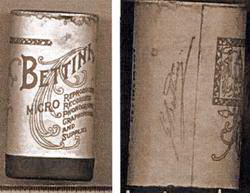
|
|
Back in 1972, Allen Koenigsberg reproduced a
Bettini accessories catalog, a few copies of which
he still has for sale (www.phonobooks.com).
Someone used rather skilled artistic creativity, a
good photocopier, some water to simulate age stains,
and thus fashioned another false Bettini cylinder box
from the reprint’s cover. And while Koenigsberg,
who clearly marked his publication with the
word "Reproduced," printed it with silver and red
lettering on a dark brown background, to reflect the
actual colors of the original catalog’s binding, the
counterfeiter changed the colors to red lettering on
a buff background (see illustration I). It is worth
noting that neither the resulting fake, nor the one
previously described, contained either original
Bettini recordings or record slips, the latter of which
are stamped, along with titles and numbers often
noted in the lieutenant’s distinctive handwriting.
To market the cylinders he produced in New York
City, Lieutenant Bettini affixed identical light blue
labels to blank standard and Concert boxes. On
the left of the front, he placed his logo-picture of
a highly stylized phonograph, sitting on a pillar,
in the front of which was a bending Romanesque
statuette. Small lettering to the right of that gave
the address of his phonograph studio, which was
at 110 Fifth Avenue, and below that were the
large, diagonal words: "Bettini Micro-Phonograph
Records." In tinier print, he warned: "None genuine
without signature," followed by a duplication
of his autograph and the words: "On Record ticket." An
American-Bettini Concert box, with one of these
labels and its accompanying cylinder are shown with
this article. They, along with the record slip, were
discovered around 1964 by collector Walter Norris
in the loft of a hotel near Nelson, New Zealand. The
record itself is a very clear rendition by soprano
Marcella Sembrich singing Strauss’s "Voci di
Primavera".
Illustration 2
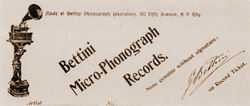
|
|
Around 1970, a collector photo-offset copies of
an original U.S. Bettini label on blue paper. These
duplicates were originally intended to be souvenirs
for other Bettini enthusiasts and have had a limited
distribution over the years. Unfortunately, they were
not marked as repros when they were printed and
some have been used to make phony Bettini boxes,
which are difficult to detect (see illustration 2).
Illustration 3
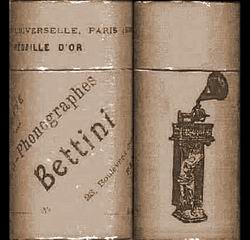
|
|
The standard cylinder boxes of the Société des
Micro-Phonographes Bettini, headquartered at 23
Boulevard des Capucines, Paris, which have black
lettering on a crimson background, were produced
ca. 1901-1903. In addition to displaying the usual
machine-on-a-pillar logo, Bettini placed that address
on the containers, and added a notation on
the side of the lids that he had won the Gold
Medal for Phonographs at the Paris Universal
Exposition of 1900 (see illustration 3). The
French-Bettini standard boxes vary, as some were
originally sold with inner tube-spindles, while others were not.
Illustration 4
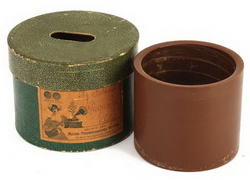
|
|
In France, Bettini’s five-inch recordings were housed
in green Pathé Stentor boxes with a marble design
(see illustration 4). Labels with yellow backgrounds
and green lettering distinctively depicted singer Lina
Cavalieri, whose image graced Bettini catalog covers
from 1901 to 1904, standing next to a phonograph.
The upper left has reproductions of the obverse and
reverse of the Paris Universal Exposition’s Gold
Medal for Phonographs, while the name and address
of Bettini’s Paris corporation appear on the center
and bottom. The lieutenant also used these labels for
his French record slips.
Gianni Bettini was granted an audience with the
aged Pope Leo XIII on February 5, 1903 and
recorded him reciting "The Benediction" and "The
Ave Maria." Shortly thereafter, he marketed these
cylinders through a distribution arrangement with
the Paris-based edition of LE FIGARO and by
advertising in periodicals such as La Vie Populaire.
The recordings, which he later also sold in disc form,
were initially in unmarked, white containers with the
Pontifical Seal embossed in red on the top
of their lids (see illustration 5).
Illustration 5
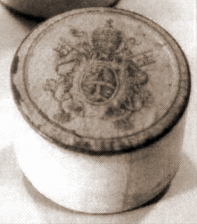
|
|
There are other cylinder cartons that, while not
directly sold by the lieutenant’s talking machine
businesses, remain indirectly linked to them.
Included in this category are the brown, shortened
Pathé boxes used by the Columbia Phonograph
Company to house Bettini’s papal recordings. The
precise remuneration Bettini received by signing
over the rights for their sale may be an amount lost
to history, but the June, 1905 issue of The Columbia
Record announced that Columbia had initiated
distributing them: "For a time, at least, they will be
within the reach of all, the price...having been fixed
at the extremely moderate figure, considering their
great desirability, of two dollars each." Record slips,
in both English and Latin, separately present the text
of these two distinct cylinders, but identical labels
appear on the lids of each.
A very different Bettini-associated cylinder container
was issued by the firm of F. J. Schwankovsky, of
238-240 Woodward Avenue, in Detroit, primarily a
wholesaler-retailer in musical instruments. Sometime
about the year 1899, Schwankovsky’s Music House,
and Schwankovsky’s Temple of Music, as the
establishment, was variously known, used the box to
indicate it was a proud distributor of Bettini’s micro-
reproducers, recorders, and speed indicators
(see illustration 6). I do not know if Schwankovsky
also sold Bettini recordings, and within this carton,
which was recently auctioned on Ebay, was a very
moldy Edison brown wax cylinder. The Schwankovsky
management, who sometimes had large display ads in the DETROIT CITY
DIRECTORY, must have been quite the innovative
entrepreneurs, as they also etched “Schwankovsky” into the wax.
Illustration 6
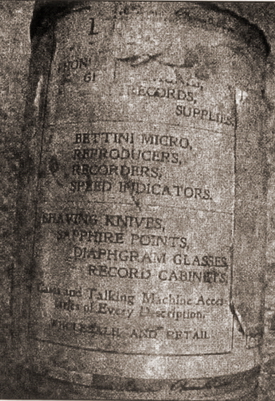
|
|
I know of only three collectors who own Judge
Publishing Company Record Department cylinders,
with their accompanying boxes (see illustration 7).
These recordings may well have been made in
Lieutenant Bettini’s studio, as the Judge Publishing
Company, was also located at 110 Fifth Avenue,
more commonly known as the Judge Building.
Moreover, William J. Arkell, president of Judge
Publishing (which produced the humor periodical
JUDGE,as well as LESLIE’S), had a close
friendship with Bettini and in both 1892 and 1899
LESLIE'S ran very complimentary articles about
the lieutenant’s phonographic achievements. Gianni
Bettini, in turn, placed advertisements for his
phonograph attachments and records in four of that
magazine's 1899 issues. Moreover, Mr. and Mrs.
Arkell, frequently attended Metropolitan Opera
House performances and were known to have
owned Bettini cylinders, thirteen of which are now
in the U.S. Library of Congress’s Recorded Sound
Section. In his "The Legacy of Gianni Bettini,"
published in the September, 1965 issue of The
Record Collector, William R. Moran presented an
encyclopedic inventory of surviving Bettini artifacts
which mentioned the Judge-type of container: "Some
key to Bettini’s relationship with a commercial
phonograph agency may be found in evidence from
a record carton. This is described as a standard
Columbia cylinder box covered with a special label
which bears the inscription:
'Record Department, JUDGE Publishing Co., 110 Fifth Ave., N.Y....Our
records are the best on the market...good quality...
excellent tunes...Bands...Orchestras... Vocal and
Instrumental solos, quartete, stories, monologues by
famous artists, 50c. each; $5.00 per dozen.’ ...Surely
it is more than a mere coincidence that Bettini
should establish his laboratory in the same building
as a company with a 'record department' engaged
in selling commercial records, and possibly also
phonographic equipment."
In 1993, the Polish National Library purchased,
two verified Bettini cylinders, which are currently
the oldest phonographic
items in its holdings.
Illustration 7
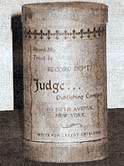
|
|
Both were recorded in 1898 and feature violinist
Dora Valesca-Becker playing separate opuses by
composer Henryk Wieniawski. At least one of
them came in a red, unmarked box, with a recessed
lip (see illustration 8). The selection’s title and
the performer’s name have been handwritten on
circular white paper which has been glued to the lid.
Although somewhat similar to the standard French
Bettini cylinder containers,it is apparent that this
box is not a genuine Bettini issue.
Illustration 8
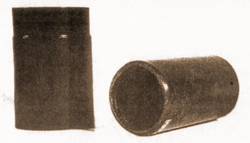
|
|
On August 6, 1903 Lieutenant Bettini was granted
French Patent No. 334,449 for a disc phonograph
and in early 1904, he printed a thirty-seven page
catalog of discs. In July ofthat year, as his Paris-
based phonograph business collapsed, he placed an
oddly capitalized, ungrammatical advertisement in
The Talking Machine News and Cinematographic
Chronicle, that indicated the extent to which his
interest had switched from cylinders to discs: "The
Disc Industry, as everyone knows, is to-day one of
the most important businesses in the world...very
large profits are guaranteed to any one which can
produce Disc Records, and it would be of the highest
value to all the manufacturers of disc machines to
add to their special industry that of the Disc Records,
the cost of manufacturing them being very small...
After many months of hard study and work, I have
completely mastered all these secret processes, and
I guarantee to produce Records as good, and even
better, than the best disc on the market at the present
time. My name is already well known in connection
with many important works and inventions relating
to the talking machine business... I am willing
to consider any proposition made to me to teach
those interested all the details of how to make Disc
Records...or I would under special conditions, accept
an exclusive association with a Company or an
individual giving satisfactory references."
This advertisement, as well as a similar one, in
German, simultaneously placed in Phonographische
Zeitschrift, produced no viable offers and the
lieutenant, who had been experimenting with
motion picture devices at least since 1897, began
to focus most of his inventive skills on them. As
for the cylinder cartons directly associated with his
phonograph businesses, I believe they only came in
the official five varieties discussed in this article:
the U.S. standard and Concert boxes, the French
standard and Stentor boxes, and the white cartons
that housed his recordings of Pope Leo XIII. I feel
certain that any other designs are bogus.
|